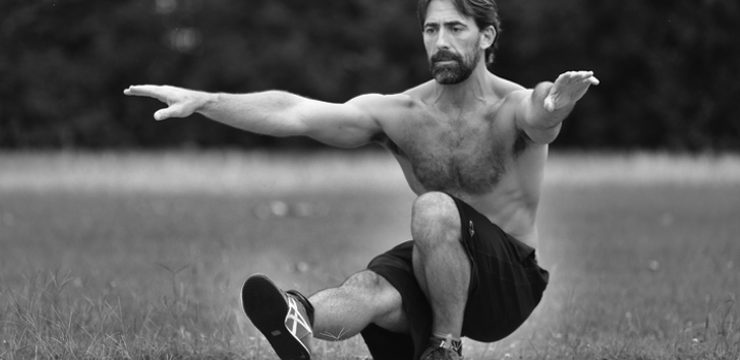Basically, if you want to compare single leg or barbell exercises there’s multiple factors that you have to take into account. This post is going to attempt to estimate an answer to this speculation.
One thing I remember reading is that you can lift higher total weight with both legs. For example if you can do 30 lbs pistols, you could do 70 or more with a two leg squat… Don’t know how accurate that is.
You actually lift less with two limbs than with one. When you’re only using one limb there is crossover irradiation of the muscles from the spine allowing you to do about ~55-60% of the total weight from a single limb lift compared to 100% from both limbs at once. This is what is called the bilateral deficit.
The reason why you can do a 30 lbs pistol and probably 150+ lbs on squat is because you’re not considering the fact that you’re lifting your other leg in each pistol (by keeping it off the ground). The total leg mass is on average about 16-18% of total body mass. For a 150 lbs person that’s about 25 lbs or so.
Pistols also typically achieve more depth than a regular ATG squat because you allow your back to round some at the bottom. So there’s no real strict comparison. You’d expect something around these numbers:
- If you’re doing a 175 lbs squat at 150 lbs bodyweight then you’re pushing approximately 175+100=275 lbs through both of your legs.
- If you’re doing a 30 lbs pistol at 150 lbs then you’re pushing 125+30=155 lbs through one leg.
- 155/275 = .56 ratio
A 30 lbs pistol means you can definitely squat more than your bodyweight on a barbell. In reality, if someone was doing a 30 lbs pistol you’d expect their squat to be probably up around 200-225 lbs at the least because of the deeper depth that you hit from pistols.
So my last question is how much do you have to pistol to approximately equal a 2x bodyweight squat which is a solid standard for a barbell lift?
We approximate with backward induction:
- 150 lbs male with 2x bodyweight squat is 300 lbs.
- 150 lbs (bodyweight) – 25 (one leg) – 25 (other leg) + 300 lbs (barbell) = 400 lbs by both legs.
- 400 * .55 ratio = 220 total lbs
- 220 lbs – (150 lbs (bodyweight) – 25 lbs (pushing leg)) = 95 lbs added to the pistol
- (95 lbs / 150 lbs bodyweight)*100% = 63% of bodyweight.
To get a 2x bodyweight barbell squat you need to pistol approximately 63% of your bodyweight. In reality, since the pistol achieves more depth than a barbell squat, I’d imagine the number is closer to 50-55% of your bodyweight in practice.
Thus, approximately 50% bodyweight pistol = 2x bodyweight squat.
There are a couple more factors to take into the equation that may throw off this number for individual users. A couple were pointed out by waldo56.
- Weighted pistols load the weight in front of the body, and hence are probably most equivalent to front squats and not back squats
- Performing weighted pistols is highly dependent on the mobility of the athlete, so direct carryover is not always applicable.
- Balance is a factor.
- Unilateral strength deficits may impair bilateral exercises, although this can be minimized from single leg training by always doing the weaker limb first, limiting volume of the stronger limb to the weaker limb, etc.
In general, what we see in reality is that the movement(s) you practice at the most you will get better at the most. If you only practice weighted pistols then you will be much better at weighted pistols than weighted squats in general. If you practice weighted barbell squats, then you may not be even good at performing pistols because of the balance, mobility, and how the weight is distributed in the movements.
Final conclusion: Practice what you want to get better at the most.
Post adapted from a previous reddit post, updated with more information. Photo from GMB’s Pistol tutorial located here. Check it out if you want some tips on how to do them!
Author: Steven Low
Steven Low is the author of Overcoming Gravity: A Systematic Approach to Gymnastics and Bodyweight Strength (Second Edition), Overcoming Poor Posture, Overcoming Tendonitis, and Overcoming Gravity Advanced Programming. He is a former gymnast who has performed with and coached the exhibitional gymnastics troupe, Gymkana. Steven has a Bachelor of Science in Biochemistry from the University of Maryland College Park, and his Doctorate of Physical Therapy from the University of Maryland Baltimore. Steven is a Senior trainer for Dragon Door’s Progressive Calisthenics Certification (PCC). He has also spent thousands of hours independently researching the scientific foundations of health, fitness and nutrition and is able to provide many insights into practical care for injuries. His training is varied and intense with a focus on gymnastics, parkour, rock climbing, and sprinting. Digital copies of the books are available in the store.
